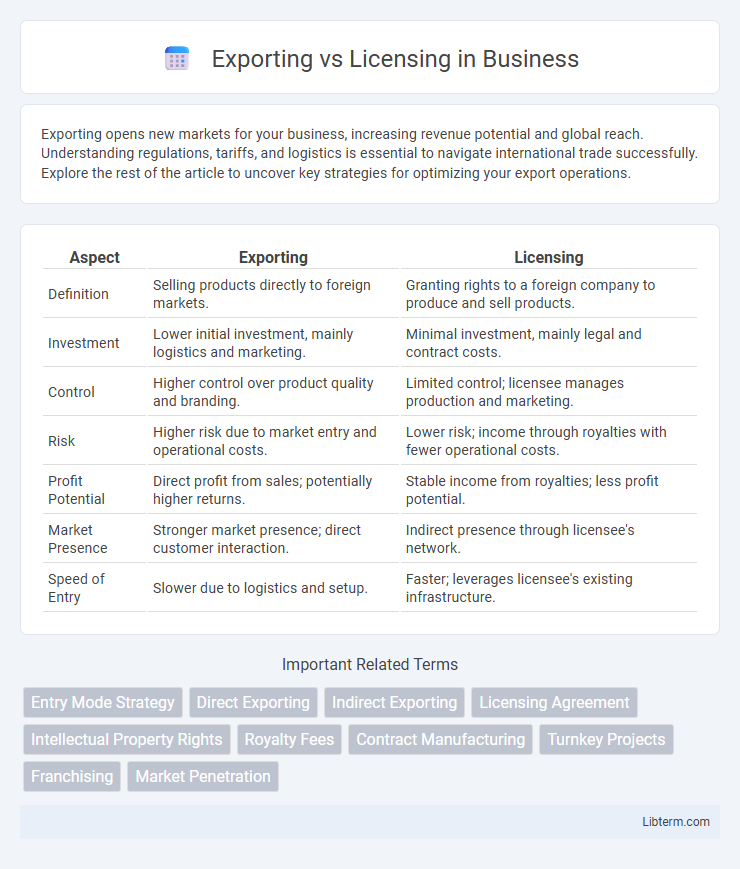Exporting opens new markets for your business, increasing revenue potential and global reach. Understanding regulations, tariffs, and logistics is essential to navigate international trade successfully. Explore the rest of the article to uncover key strategies for optimizing your export operations.
Table of Comparison
| Aspect | Exporting | Licensing |
|---|---|---|
| Definition | Selling products directly to foreign markets. | Granting rights to a foreign company to produce and sell products. |
| Investment | Lower initial investment, mainly logistics and marketing. | Minimal investment, mainly legal and contract costs. |
| Control | Higher control over product quality and branding. | Limited control; licensee manages production and marketing. |
| Risk | Higher risk due to market entry and operational costs. | Lower risk; income through royalties with fewer operational costs. |
| Profit Potential | Direct profit from sales; potentially higher returns. | Stable income from royalties; less profit potential. |
| Market Presence | Stronger market presence; direct customer interaction. | Indirect presence through licensee's network. |
| Speed of Entry | Slower due to logistics and setup. | Faster; leverages licensee's existing infrastructure. |
Introduction to Exporting and Licensing
Exporting involves selling products manufactured in one country to customers in another, providing direct control over the market and brand presence. Licensing grants a foreign company the rights to produce and sell products using the licensor's intellectual property, enabling rapid market entry with lower investment risks. Both strategies serve as key methods for international expansion, balancing control, cost, and risk differently.
Defining Exporting and Its Key Features
Exporting involves selling goods or services produced in one country to customers in another, enabling businesses to expand their market reach internationally. Key features include direct control over production and quality, lower risk compared to foreign investment, and the need to navigate tariffs, regulations, and shipping logistics. Exporting allows companies to test foreign markets with minimal financial exposure while leveraging existing production capabilities.
Understanding Licensing: A Comprehensive Overview
Licensing involves granting a foreign company the rights to produce and sell products using your intellectual property, such as patents, trademarks, or technology, in exchange for royalties or fees. This method reduces the financial risk and investment required compared to exporting, as the licensee handles production and distribution locally. Understanding licensing enables businesses to expand their market presence efficiently while maintaining control over their brand and innovations.
Advantages of Exporting for Businesses
Exporting offers businesses direct access to international markets, enabling greater control over product quality, branding, and customer relationships. It requires lower initial investment and reduces risks compared to establishing foreign subsidiaries, while allowing companies to leverage existing production capacity efficiently. Exporting also enables faster market entry and better adaptation to local demand through direct feedback and market presence.
Benefits and Drawbacks of Licensing
Licensing offers companies a low-risk entry into foreign markets by allowing them to capitalize on established brands and intellectual property without significant investment in manufacturing or distribution. It enables quick revenue generation and reduces operational costs but may result in limited control over marketing strategies and potential quality discrepancies. Dependence on licensees can also expose the licensor to risks related to brand reputation and intellectual property protection.
Comparative Analysis: Exporting vs Licensing
Exporting involves selling products directly to foreign markets, allowing greater control over branding and pricing but higher upfront costs and logistical challenges. Licensing permits a foreign company to produce and sell products under a licensor's brand, reducing investment risks and entry barriers but sacrificing control and potential profit margins. The choice depends on market size, resource availability, and long-term strategic goals, with exporting favored for maintaining control and licensing preferred for rapid market penetration.
Factors Influencing the Choice Between Exporting and Licensing
Factors influencing the choice between exporting and licensing include market control, investment risk, and resource commitment. Exporting requires higher upfront costs and greater control over product quality and branding, making it suitable for companies seeking direct market presence. Licensing reduces financial risk and operational involvement by allowing local entities to produce and sell, which is advantageous in markets with complex regulations or high entry barriers.
Risks and Challenges Associated with Both Strategies
Exporting involves risks such as high transportation costs, tariffs, and exposure to currency fluctuations, potentially reducing profit margins. Licensing poses challenges including loss of control over product quality and brand reputation, as well as the risk of intellectual property theft or misuse. Both strategies require careful market analysis and risk management to navigate legal, cultural, and operational complexities effectively.
Case Studies: Successful Exporting and Licensing Examples
Caterpillar's success in exporting heavy machinery demonstrates the strategic advantage of maintaining control over product quality and brand reputation while entering global markets. On the licensing front, Disney's extensive use of licensing agreements for character merchandise has enabled rapid international expansion with low operational risk and investment. Both case studies highlight how companies leverage exporting for market penetration and licensing for brand proliferation, optimizing global growth strategies.
Conclusion: Choosing the Right Market Entry Strategy
Exporting offers direct control over product distribution and brand management, ideal for companies seeking minimal investment with moderate risk. Licensing provides a low-cost, low-risk approach by granting rights to third parties, suitable for firms lacking local market expertise or capital. The optimal market entry strategy depends on balancing control, resource commitment, and market knowledge to align with long-term business objectives.
Exporting Infographic

 libterm.com
libterm.com